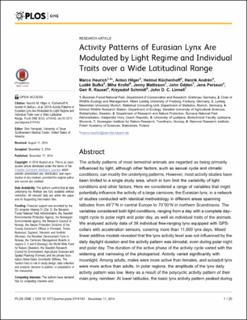Activity patterns of Eurasian lynx are modulated by light regime and individual traits over a wide latitudinal range
Heurich, Marco; Hilger, Anton; Küchenhoff, Helmut; Andrén, Henrik; Bufka, Luděk; Krofel, Miha; Mattisson, Jenny; Odden, John; Persson, Jens; Rauset, Geir Rune; Schmidt, Krzysztof; Linnell, John Durrus
Peer reviewed, Journal article
Published version

View/
Date
2014Metadata
Show full item recordCollections
- Publikasjoner fra CRIStin - NINA [2364]
- Scientific publications [1392]
Original version
10.1371/journal.pone.0114143Abstract
The activity patterns of most terrestrial animals are regarded as being primarily influenced by light, although other factors, such as sexual cycle and climatic conditions, can modify the underlying patterns. However, most activity studies have been limited to a single study area, which in turn limit the variability of light conditions and other factors. Here we considered a range of variables that might potentially influence the activity of a large carnivore, the Eurasian lynx, in a network of studies conducted with identical methodology in different areas spanning latitudes from 49˚79N in central Europe to 70˚009N in northern Scandinavia. The variables considered both light conditions, ranging from a day with a complete day– night cycle to polar night and polar day, as well as individual traits of the animals. We analysed activity data of 38 individual free-ranging lynx equipped with GPScollars with acceleration sensors, covering more than 11,000 lynx days. Mixed linear additive models revealed that the lynx activity level was not influenced by the daily daylight duration and the activity pattern was bimodal, even during polar night and polar day. The duration of the active phase of the activity cycle varied with the widening and narrowing of the photoperiod. Activity varied significantly with moonlight. Among adults, males were more active than females, and subadult lynx were more active than adults. In polar regions, the amplitude of the lynx daily activity pattern was low, likely as a result of the polycyclic activity pattern of their main prey, reindeer. At lower latitudes, the basic lynx activity pattern peaked during twilight, corresponding to the crepuscular activity pattern of the main prey, roe deer. Our results indicated that the basic activity of lynx is independent of light conditions, but is modified by both individual traits and the activity pattern of the locally most important prey. Activity patterns of Eurasian lynx are modulated by light regime and individual traits over a wide latitudinal range
